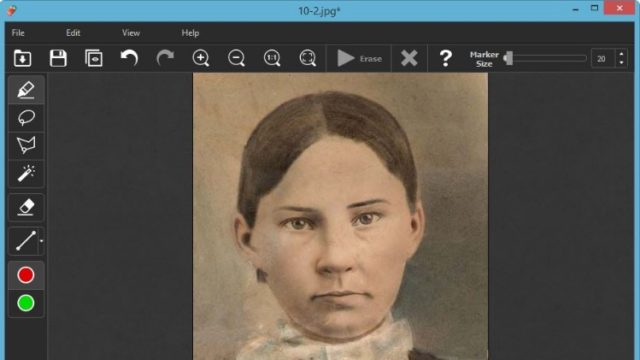

These approaches can achieve convincing results in filling missing pixels and restoring scratches. The representative approaches include the K-SVD-based approach and the MCA-based approach.
#Inpaint photo restoration Patch
Its basic idea is to calculate the sparse representation coefficient of the damaged patch on the over-complete dictionary, and then restore the damaged patch according to the sparse representation coefficient and the over-complete dictionary. The third is based on the sparse representation. However, they also have some disadvantages, such as unreasonable restoration order, mismatch error and error accumulation, low efficiency due to greedy search, and so on. The advantage of these approaches is they can obtain satisfactory results in restoring the large damaged regions. The representative approaches include the non-parametric sampling approach, the exemplar-based approach, the patch-sparsity-based approach, and the nonlocal-means approach. Its basic idea is that the missing region is restored using the similar patch in a visually plausible manner at the patch level. The second is based on the exemplar, which is also commonly used method at present. For the small and non-textured damaged regions, these approaches can achieve convincingly excellent result, but for the large and textured missing regions they tend to induce over-smooth effect or stair-case effect.
#Inpaint photo restoration tv
The representative approaches include the BSCB model, the TV model, and the CDD model. Its basic idea is that the missing region is filled smoothly by diffusing the effective information from the undamaged region into the damaged region at the pixel level. The first is based on the Partial Differential Equation (PDE). Īt present, the existing inpainting approaches can be classified into three categories. With the rapid development of computer and multimedia technology, the inpainting technology has been widely used in many fields, such as scratches restoration of old photos and precious literatures, protection of cultural relics, robot vision, film and television special effects production, and so on. Its main purpose is to make the restored image meet the requirements of human vision, so that people who are not familiar with the original image cannot notice the restoration trace. Its basic idea is to use the undamaged and effective information to restore the damaged regions according to certain rules. Image inpainting derives from the restoration of damaged artworks. Experimental results show that the proposed method can effectively prevent the occurrence of mismatch error and improve the restoration effect. Finally, we use the exemplar patch to restore the target patch. Thirdly, based on MSD and SMD, we define a new matching rule and use it to find the most similar exemplar patch in the source region. Secondly, we define the SMD (Square of Mean Differences) and use it to measure the degree of differences between the pixels at known positions in the target patch and the pixels at unknown positions in the exemplar patch. Firstly, we define the MSD (Mean of Squared Differences) and use it to measure the degree of differences between corresponding pixels at known positions in the target patch and the exemplar patch. In view of these problems, we propose an inpainting method for object removal based on difference degree constraint. Finally some unexpected objects may be introduced into the target region, making the result unable to meet the requirements of visual consistency. Even worse, the error may be accumulated along with the process continues. Although the matching rule is relatively simple, it is likely to lead to the occurrence of mismatch error. In the inpainting method for object removal, SSD (Sum of Squared Differences) is commonly used to measure the degree of similarity between the exemplar patch and the target patch, which has a very important impact on the restoration results.


 0 kommentar(er)
0 kommentar(er)
